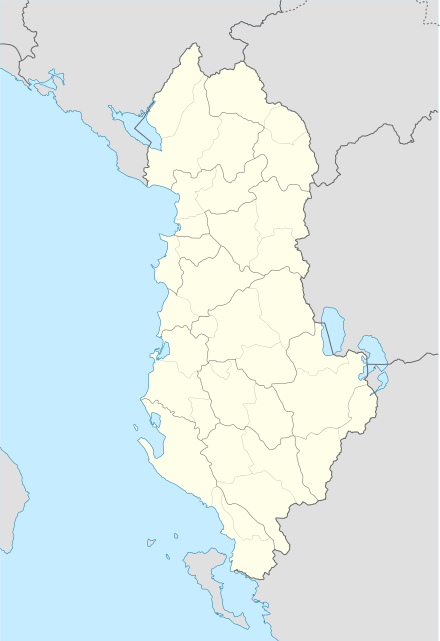Himarë (town)
Himarë (definite Albanian form: Himara / in Greek: Χειμάρρα, romanized: Himárra) is a bilingual town in Southern Albania along the Albanian Riviera and part of the Vlorë County. It is the largest settlement and the seat of the municipality of Himarë.[1] Both the town and municipality are populated by an ethnic Greek community.[2][3][4]
Himarë | |
|---|---|
 | |
 Himarë | |
| Coordinates: 40°6′5″N 19°44′48″E | |
| Country | |
| County | Vlorë |
| Municipality | Himarë |
| Municipal unit | Himarë |
| Time zone | UTC+1 (CET) |
| • Summer (DST) | UTC+2 (CEST) |
| Postal Code | 9425 |
| Area Code | 0393 |
| Vehicle registration | VL |
| Website | www.himara.gov.al |
History
In antiquity the region was inhabited by the Greek tribe of the Chaonians.[5] The town of Himarë is believed to have been founded as Χίμαιρα,[6] (Chimaira[7] or Chimaera,[8] hence the name Himara) by the Chaonians as a trading outpost on the Chaonian shore. However, another theory according to the name suggest that comes from Greek χείμαρρος (cheimarros), meaning "torrent".[9]
The town is noted among ancient writers, including Pliny the Elder[10] and Procopius.[11]
The town of Himara during the 16th-18th centuries was ecclesiastically under the jurisdiction of Rome, and some of its inhabitants were Catholics of the Eastern rite.[12]
Notable people
- Christos Bekas, Greek Army general in the Greek War of Independence (1821–1830).[13]* Vasil Bollano, former mayor of Himarë and President of the organization of the Greek minority, "Omonoia".
- Pyrros Dimas, the world-famous Greek weight-lifting athlete, whose nickname is "the Lion of Himara". He is the only weight-lifter in the world to have won four Olympic medals. Three of his medals are gold (1992 Summer Olympics, 1996 Summer Olympics, 2000 Summer Olympics) and the last one, from the Athens 2004 Olympics, is a bronze.
- Christos Armandos Gezos, novelist and poet.
- Kostas Kaznezis, Greek Army general in the Greek War of Independence.[14]
- Zachos Milios (1805–1860), Greek Army officer and revolutionary.
- Paskal Milo politician
- Spyromilios (1800–1880), Greek Army general and politician.
- Spyros Spyromilios (1864–1930), Greek Gendarmerie officer, declared the region's autonomy (1914).
- Pyrros Spyromilios (1913–1961), Greek Navy officer
- Ayas Mehmed Pasha (1483–1539), grand vizier of the Ottoman Empire from 1536 to 1539.
References
- "Law nr. 115/2014" (PDF). Archived from the original (PDF) on 2015-09-24. Retrieved 2015-07-01.
- Europa Publications Limited. Central and South-Eastern Europe 2004, Volume 5. Routledge, 2003. ISBN 978-1-85743-186-5, p. 78.
- Economist Intelligence Unit. (Great Britain). Country report: Albania, Issue 1., 2001.
- "Albania: The state of a nation". ICG Balkans Report N°111. p. 15. Archived from the original (PDF) on 2010-08-08. Retrieved 2010-09-02.
The coastal Himara region of Southern Albania has always had a predominantly ethnic Greek population.
- Hammond, NGL (1994). Philip of Macedon. London, UK: Duckworth. "Epirus was a land of milk and animal products...The social unit was a small tribe, consisting of several nomadic or semi-nomadic groups, and these tribes, of which more than seventy names are known, coalesced into large tribal coalitions, three in number: Thesprotians, Molossians and Chaonians...We know from the discovery of inscriptions that these tribes were speaking the Greek language (in a West-Greek dialect)"
- An Inventory of Archaic and Classical Poleis: An Investigation Conducted by The Copenhagen Polis Centre for the Danish National Research Foundation by Mogens Herman Hansen, 2005, page 340.
- Chimaira, Henry George Liddell, Robert Scott, A Greek-English Lexicon, at Perseus
-

- Cheimarros, Henry George Liddell, Robert Scott, A Greek-English Lexicon, at Perseus
- Pliny. Naturalis Historia. 4.1.
- Procopius, de Aedif 4.4.
- Nilo Borgia: I monaci basiliani d'Italia in Albania: appunti di storia missionaria, secoli XVI-XVIII, periodo secondo. Reale Accademia d'Italia. Centro di studi per l'Albania. 1942. pp. 73, 113.
- Banac, Ackerman, Szporluk, Vucinich, 1981: p. 46
- Banac, Ackerman, Szporluk, Vucinich, 1981: p. 46
